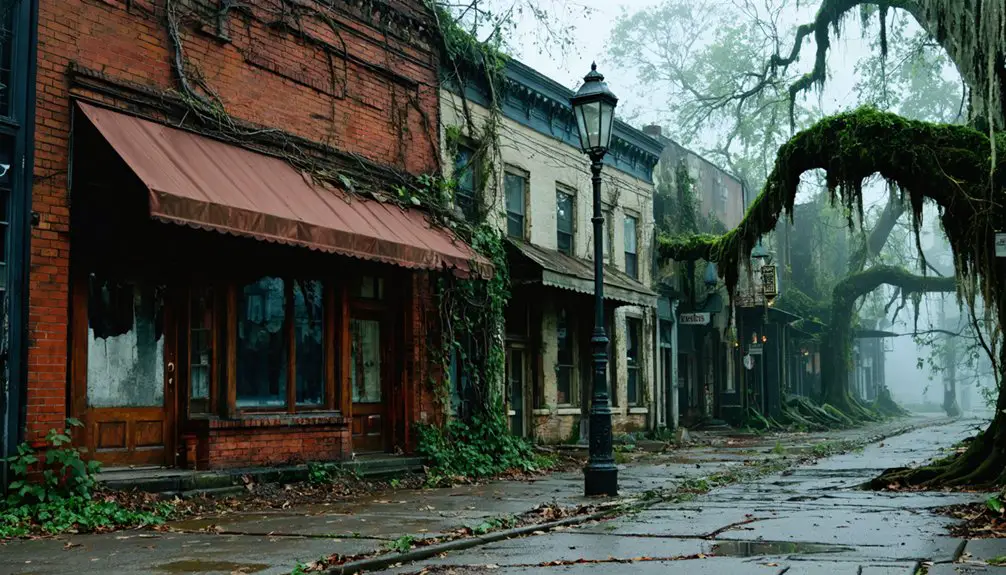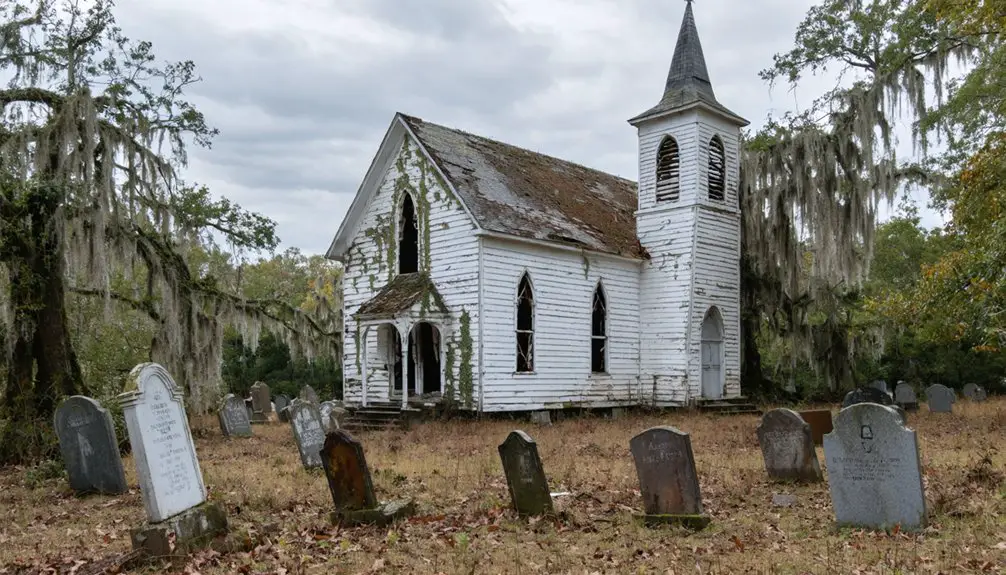You’ll find Mettzendorf’s remnants scattered across rural South Carolina, where brick shells and an abandoned cotton gin stand as witnesses to its agricultural past. The town’s decline stemmed from shifting economic forces, including failing farms and bypassed transportation routes that drove younger residents to urban areas. Today, crumbling storefronts with vintage barber shop signs, a historic rail line, and the Oliver family cemetery offer glimpses into this ghost town’s mysterious legacy.
Key Takeaways
- Mettzendorf began as an agricultural settlement with a general store and post office before declining into an abandoned ghost town.
- Architectural remnants include brick buildings with dental molding, an abandoned cotton gin, and historic storefronts from its prosperous past.
- The town’s abandonment resulted from declining farming viability, closed mining operations, and younger residents migrating to urban areas.
- The Oliver family cemetery and crumbling religious structures remain as physical evidence of early settlement in the area.
- Current preservation efforts face challenges from natural decay, unclear land ownership, and limited funding to protect remaining historical structures.
The Rise and Fall of Mettzendorf
While many small farming communities emerged in rural South Carolina during the 19th century, Mettzendorf began as a modest settlement centered around agricultural production and local commerce.
You’d have found a general store and possibly a post office along its dirt roads, serving as crucial gathering spots for local farmers and residents.
Similar to what happened at Ellas Grove Store, the general store would have been the economic heart of the community during its prime years.
The community’s economic shifts mirrored the region’s agricultural cycles, reaching its peak when farming prosperity supported a stable population.
Like many ghost towns today, it attracts curious visitors and paranormal enthusiasts seeking to explore its abandoned structures.
Yet Mettzendorf’s community evolution took a downturn as modern agricultural practices and urbanization reshaped rural life.
Without industrial development or major transportation routes, the town couldn’t sustain itself. Young residents moved away seeking opportunities elsewhere, while necessary services gradually shut down.
Eventually, Mettzendorf succumbed to abandonment, leaving only deteriorating structures as proof of its existence.
Hidden History in the South Carolina Landscape
You’ll find Mettzendorf’s hidden landmarks scattered across South Carolina’s landscape, where forgotten structures and artifacts tell stories of a once-thriving community.
The remnants provide essential historical evidence of early settlement patterns, industrial development, and social life that shaped this region of South Carolina. Similar to how proper permission must be obtained before accessing historical structures and grounds, Hamburg faced the challenge of rebuilding after its Great Fire of 1842 destroyed a quarter of its inner city.
These untold stories emerge through careful examination of remaining foundations, overgrown pathways, and scattered artifacts that connect modern visitors to the town’s vanished past.
Lost Landmarks Await Discovery
Hidden beneath South Carolina’s modern landscape lies a network of forgotten industrial and colonial landmarks waiting to be rediscovered.
Hidden within these ghost towns, many travelers still encounter company script currency, remnants of Ferguson’s unique payment system that ultimately led to its downfall.
You’ll find lost architecture ranging from abandoned textile mills to submerged town foundations, each telling stories of community memories shaped by economic shifts and environmental forces. Located 15 miles from Charleston, Dorchester stands as one of the state’s most historically significant abandoned settlements.
As you explore these vanished places, you’ll encounter:
- Colonial-era ruins like Dorchester’s bell towers and tabby fort walls
- Industrial remnants of company stores and mill foundations from towns like Ferguson
- Underwater ghost towns accessible only by boat, such as portions of Andersonville beneath Lake Hartwell
These sites preserve vital evidence of South Carolina’s industrial and agricultural heritage, where flooding, economic decline, and infrastructure projects transformed thriving communities into historical mysteries waiting for your discovery.
Heritage Through Untold Stories
Beyond the physical remnants of South Carolina’s ghost towns lies a rich tapestry of untold stories that shape the state’s cultural heritage.
You’ll discover how these abandoned places reflect more than simple desertion – they’re windows into complex social upheavals and economic transformations that reshaped entire communities.
The untold narratives of places like Ferguson reveal how company-issued, non-transferrable wages trapped workers in cycles of dependency, while Andersonville’s story shows nature’s power to reshape human settlements through devastating floods. Similarly, the term “ghost town” was incorrectly applied to Clementia Village, which was actually a mineral springs business rather than an abandoned residential community. Like Elkmont in Tennessee, these communities often evolved from thriving resort towns into abandoned shells of their former glory.
These sites’ cultural significance extends beyond their physical remains – they’re preserved in continuing place names and post offices that bridge past and present.
Even submerged towns, accessible only by boat, continue telling their stories through the unique heritage landscapes they’ve created, where natural and human histories intertwine beneath South Carolina’s waters.
Exploring What Remains Today
As you traverse Mettzendorf’s quiet streets today, you’ll encounter deteriorating storefronts and partially roofed buildings that hint at the town’s bustling commercial past.
The remnants include vintage barber shop signs, an abandoned cotton gin, and weathered farmhouses that stand as silent witnesses to the community’s agricultural heritage. Several graves in the Oliver family cemetery tell stories of the town’s earliest inhabitants. Walking through downtown reveals a striking resemblance to a ghost town atmosphere, much like the nearby Chester area.
Church bells still mark time near crumbling religious structures, while the active rail line serves as a reminder of the town’s former connectivity to the wider region.
Physical Traces Still Standing
While much of Mettzendorf has succumbed to decades of abandonment, several physical traces still stand as evidence to this once-thriving South Carolina community.
You’ll find architectural remnants scattered throughout the area, including brick and tabby building shells with ornate dental molding still visible on some storefronts. Agricultural vestiges dot the landscape in the form of dilapidated farmhouses and skeletal wooden frames of old barns and smokehouses.
If you’re exploring the site today, you’ll discover:
- Isolated brick chimneys and fireplaces standing where homes once existed
- Store facades constructed of durable materials like brick and stone
- Depressions and stone bases marking the foundations of former buildings
Natural reclamation continues to obscure these remnants as vegetation overtakes the site and erosion reshapes the landscape.
Hidden Historical Markers Revealed
Today’s visitors to Mettzendorf must search carefully to find the few historical markers that chronicle this abandoned settlement‘s past.
You’ll notice that many markers have succumbed to neglect – they’re often obscured by vegetation or damaged by weather. While local heritage societies occasionally install temporary markers during community events, the marker significance remains limited due to their sparse placement and incomplete historical narrative.
The historical obscurity of Mettzendorf is reflected in these weathered signs, which typically offer only basic information about founding dates and early settlers.
You won’t find detailed storytelling here – funding constraints and limited public interest have prevented the installation of thorough signage. Some markers have even disappeared entirely, relocated or removed as modern development encroaches on this forgotten landscape.
Local Legends and Folklore
Legends surrounding Mettzendorf’s abandoned landscape have captivated South Carolina residents for generations, with tales of mysterious lights, unexplained noises, and wandering spirits near the old railroad lines.
You’ll find numerous accounts of ghostly encounters along the historic rail paths, where witnesses report spectral sightings of lantern-carrying figures moving through the mist.
Local folklore points to three primary supernatural phenomena:
- Glowing orbs that hover above former railroad tracks, possibly linked to seismic activity
- Unexplained whispers and door movements in abandoned buildings, particularly near old gravesites
- Apparitions of early settlers, including members of the Davis family, whose general store once served as the town’s hub
Scientific studies suggest these phenomena might’ve natural explanations, with fault lines and old metallic infrastructure potentially causing some of these mysterious occurrences.
Economic Forces Behind the Abandonment

Beyond the ghostly tales and mysterious happenings, the stark economic realities that emptied Mettzendorf tell an equally compelling story.
You’ll find the roots of the town’s economic decline in the devastating shifts that transformed rural South Carolina. As farming became less viable and nearby mining operations shut down, the community faced unprecedented displacement.
The town’s isolation deepened when new transportation routes bypassed it completely, cutting off essential commercial lifelines.
When progress redirected traffic elsewhere, Mettzendorf’s lifeblood slowly drained away, leaving the town stranded in economic solitude.
You can trace how younger residents fled to urban centers, leaving aging populations struggling to maintain local businesses. Without industrial diversification or government support, Mettzendorf couldn’t weather the perfect storm of market pressures, declining property values, and crumbling infrastructure.
The town’s abandonment wasn’t supernatural – it was the predictable result of ruthless economic forces reshaping rural America.
Preservation Challenges and Legacy
Despite ongoing preservation efforts, Mettzendorf faces severe challenges that threaten its remaining structural heritage and historical legacy. The site’s preservation obstacles stem from complex legal issues, financial constraints, and environmental degradation that you’ll find typical in ghost town conservation projects.
Key challenges affecting Mettzendorf’s cultural heritage include:
- Natural decay accelerated by vegetation overgrowth, flooding, and soil erosion
- Unclear land ownership rights and legal disputes that hinder preservation activities
- Limited funding resources and competition with other historical sites for grants
You’ll notice these issues are compounded by insufficient public awareness and educational outreach.
While the town serves as a crucial link to South Carolina’s post-colonial development, the lack of coordinated preservation efforts continues to jeopardize its remaining physical structures and historical significance.
Frequently Asked Questions
Are There Any Known Photographs of Mettzendorf Before Its Abandonment?
Despite searching through over 50 South Carolina historical archives, you won’t find any confirmed photographs of Mettzendorf before abandonment. The town’s visual history remains undocumented, like many small ghost towns from that era.
What Native American Tribes Originally Inhabited the Mettzendorf Area?
You’ll find the St. Helena, Edisto, Kussoe, Kiawah, and Etiwan tribes originally inhabited this area, with later Catawba Culture influences. These Lowcountry natives adapted perfectly to the coastal environment.
Did Any Notable Civil War Battles or Skirmishes Occur Near Mettzendorf?
You won’t find any documented Civil War battles or local skirmishes in Mettzendorf’s historical records. Major military actions in South Carolina occurred primarily around Charleston Harbor and strategic river crossings elsewhere.
What Was the Estimated Peak Population of Mettzendorf?
You’d laugh at how those population dynamics experts dance around this one – but there’s no verified peak population for this historically significant spot. Best educated guess? Probably 100-500 at its height.
Were There Any Documented Murders or Crimes in Mettzendorf’s History?
You won’t find any documented murders or crimes in historical records, despite local unsolved mysteries and ghost sightings. Available sources show no specific evidence of violent crimes or criminal incidents.
References
- https://www.randomconnections.com/ghost-towns-of-the-pee-dee-part-1-ellas-grove-and-palmer/
- https://www.onlyinyourstate.com/experiences/south-carolina/5-creepy-sc-ghost-towns
- https://www.smithsonianmag.com/smart-news/the-ghost-haunting-this-south-carolina-town-might-have-an-earthly-explanation-scientist-says-180985975/
- https://sctravelguide.com/2018/06/11/south-carolina-ghost-towns/
- https://www.randomconnections.com/ghost-towns-of-south-carolina/
- https://www.onlyinyourstate.com/state-pride/south-carolina/old-ellenton-abandoned-town-sc
- https://967stevefm.iheart.com/content/2023-10-11-abandoned-south-carolina-town-named-the-creepiest-ghost-town-in-the-state/
- https://en.wikipedia.org/wiki/Hamburg
- https://www.randomconnections.com/update-on-ghost-town-research/
- https://www.loveexploring.com/gallerylist/188219/the-us-state-with-the-most-ghost-towns-revealed



